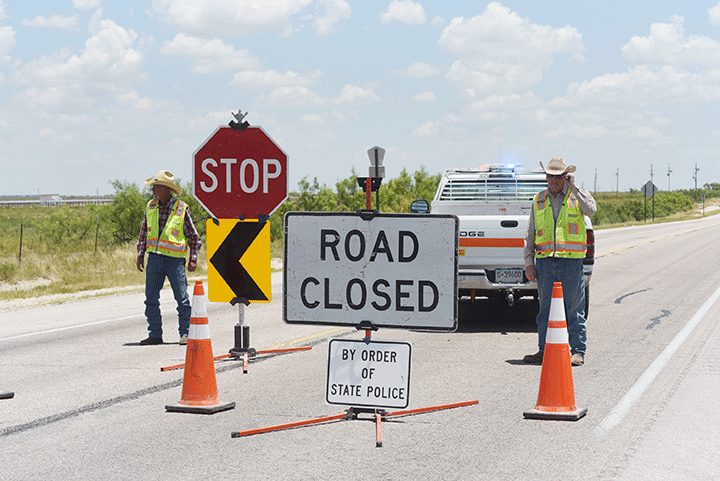
Six to eight years.
In a perfect world, Michael Sandoval believes that is the amount of time needed for three of Southeastern New Mexico’s major roads used for oil and gas traffic to be rebuilt to meet the ongoing traffic issues.
Those roads are N.M. Hwy. 285, from the Texas border to Carlsbad, N.M., Hwy. 31 from Hwy. 285 to Hwy. 62-180 and N.M. Hwy. 128 from the Texas/New Mexico border east of Jal to Hwy. 31. The plan is to make them all four-laned roads.
After that he feels repairing and improving N.M. Hwy 176, Hwy. 18 and U.S. Hwy. 380 from Roswell through Tatum to the Texas/New Mexico border are also on the NMDOT’s radar.
“We will just see how it goes,” said Sandoval, cabinet secretary of the New Mexico Department of Transportation. He and the New Mexico State Transportation Commission held a meeting Thursday in Jal, specifically to see for themselves the overwhelming need for safer roads in southeastern New Mexico.

That “perfect world” includes getting the design and utility work complete and finding the appropriate number of construction companies. To build it engineers are planning to use a “design-to-build” construction plan where portions of a road can be built, while other portions undergo the preliminary work needed to engineer the roads.
A large part of the plan also means receiving the necessary funding for these construction projects. Hwy. 128 will cost $200 million, while U.S. 285 and Hwy. 31 are $110 million and $130 million, respectively. Sandoval said the projects for U.S. 285 and Hwy. 31 are already funded, while $60 million has been earmarked for Hwy. 128.
Still everyone in this part of the state knows where those dollars come from.
“If the surplus is there, some of that money is going to come back down here,” said Sandoval.
That surplus is the added money the state of New Mexico has received from the area’s high oil and gas production. During the 2019 Legislature, the state government had about $1.2 billion in surplus money, most of which was not used to help the roads the oil and gas industry needs to continue its production.
“I’d love to see that,” Sandoval said of a continued surplus. “I’d love to see the traffic continue, because that means the industry is successful and busy. If we can just build the infrastructure to support it, then it is a win-win situation.”
While six to eight years is a long time to wait, Sandoval believes the work on these roads are two to four years away from starting.
“One of the things that I hear is, ‘hey we have money now, when are shovels are going into the ground and things will start changing?’” Sandoval said. “What I have tried to let people know is something difficult because it is not what they want to hear. It’s going to take two to four years to get things started.”
Sandoval calls the current surplus situation — if it continues — like “hitting the lottery.”
“For years and years we barely had enough money to band-aid roads together,” Sandoval said. “Basically overnight we have the biggest budget we have had in 30 years. Which is great and we are to keep asking for money and hopefully receiving it.”
The hard part, Sandoval said, is trying to meet everyone’s timing expectations. Sandoval said when the 2019 Legislature met in January, there was money available but no plan.
“We are starting from scratch,” Sandoval said. “We didn’t have designs for N.M. 31, or 128. We didn’t have any utility work done. Now that we have money, we have to start design work and make sure all of the utilities are taken care of. Some of those intersections are complicated with the rail, working with private companies to go over and under their rail tracks.”
So when Sandoval’s answer is two to four years, that is not the answer people in southeastern New Mexico want to hear.
Once the roads are built, Sandoval also wants to make sure they survive the full 20-25-year lifespan. That will include additional funding needed to maintain the roads. The key is to not build them and just leave them alone to break down.
“We have to maintain our roads like we maintain our cars,” Sandoval said. “You always have to do work on your car in terms of oil changes, tire changes and such to keep your car running. The same idea is needed for our roads.”
Sen. Gay Kernan, R-Hobbs, believes the six- to eight-year wait it’s acceptable.
“I know that’s probably a true statement,” Kernan said of the time frame. “I know it’s difficult for people to understand all of the preliminary work that has to be done. I am really pleased they are doing the ‘design build’ because that will decrease the timeline. It’s a better way to do business and we are happy about that.”
Sen. Gregg Fulfer, R-Jal, hopes Sandoval’s plan doesn’t get cluttered with the bureaucratic red tape often found in governmental projects.
“Unfortunately in government it takes four years to do anything,” Fulfer said. “It just takes a long time for the money to work its way down to the shovel.”
Fulfer said the time frame is a proven opportunity given by the shale oil revolution.
“If we can spend the money right and put it into infrastructure and build the state, we are built then for future generations going forward,” Fulfer said. “So this is our opportunity, let’s not waste the money. Let’s put it where it needs to be. I’m thankful for the department of transportation. They see there is an opportunity here to get the infrastructure built up and get us to where we are lasting for generations. That is what we need.”
Todd Bailey can be reached at editor@hobbsnews.com.












